In July 2025, AntibodySystem products continued to provide robust support for global scientific research, being cited in academic journals such as Nature Cardiovascular Research, Journal of Medicinal Chemistry, Cancers, International Journal of Molecular Sciences, and others. The research covered diverse fields including immunotherapy for hematological malignancies, Mycoplasma pneumoniae vaccine development, targeted drug exploration for prostate cancer, monkeypox virus inhibition, and molecular mechanisms in hematopoietic stem cells! Moving forward, AntibodySystem will continue to collaborate with global research teams, supporting life science exploration with innovative reagents and technologies to scale new scientific heights! Join Dr. Connie today to explore part of the AntibodySystem product citations from July!
1
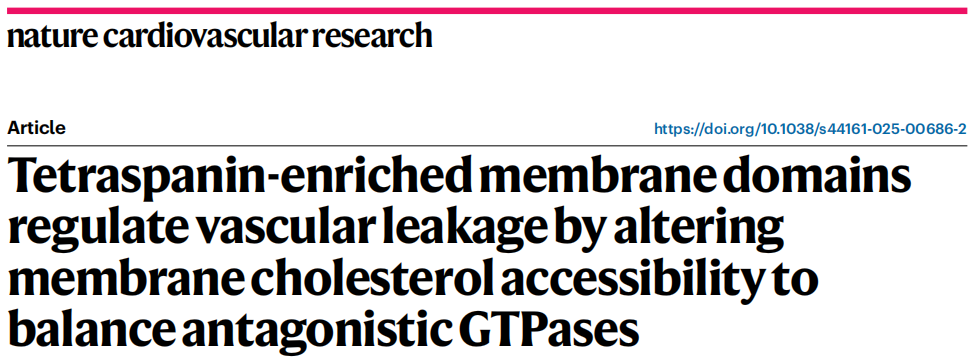
|
Title |
Tetraspanin-enriched membrane domains regulate vascular leakage by altering membrane cholesterol accessibility to balance antagonistic GTPases |
|
Journal Information |
Nat Cardiovasc Res. 2025 Jul 29. |
|
Cited products |
|
|
Catalog |
Product Name |
|
Recombinant Human OSBPL2 Protein, N-His |
|
This study revealed the mechanism by which the tetraspanin CD82 in endothelial cells promotes inflammatory vascular leakage. CD82 regulates the distribution and transport of "accessible cholesterol" (AC) on the plasma membrane (PM), thereby unbalancing antagonistic small GTPase signaling pathways (inhibiting Cdc42 activity/maintaining RhoA activity). CD82 interacts with the cholesterol transport protein ORP2, forming tetraspanin-enriched membrane domains (TEMDs) that maintain AC enrichment at the PM. Accumulation of AC further restricts membrane anchoring of the Cdc42 activator FARP1 while promoting membrane dissociation of the RhoA inhibitor Rnd3, ultimately leading to endothelial barrier disruption. The study also found that statins (e.g., simvastatin) or ORP inhibitors (OSW-1) reduced AC levels, inhibiting this pathway and alleviating vascular leakage, offering new therapeutic targets for inflammatory diseases (e.g., sepsis, COVID-19).
This article cited AntibodySystem's Recombinant Human OSBPL2 Protein, N-His (Cat. No. YHK80001) for Microscale Thermophoresis (MST) experiments to detect its direct interaction with CD82. The results showed that ORP2 directly binds CD82 with a dissociation constant (Kd) of 21.1 ± 7.25 μM. It was concluded that CD82 interacts with ORP2 via its intracellular C-terminal domain, mediating non-vesicular transport of cholesterol from organelles to the PM, thereby regulating PM AC levels and subsequently affecting the balance of RhoA and Cdc42 activity, contributing to vascular endothelial inflammatory responses.
2
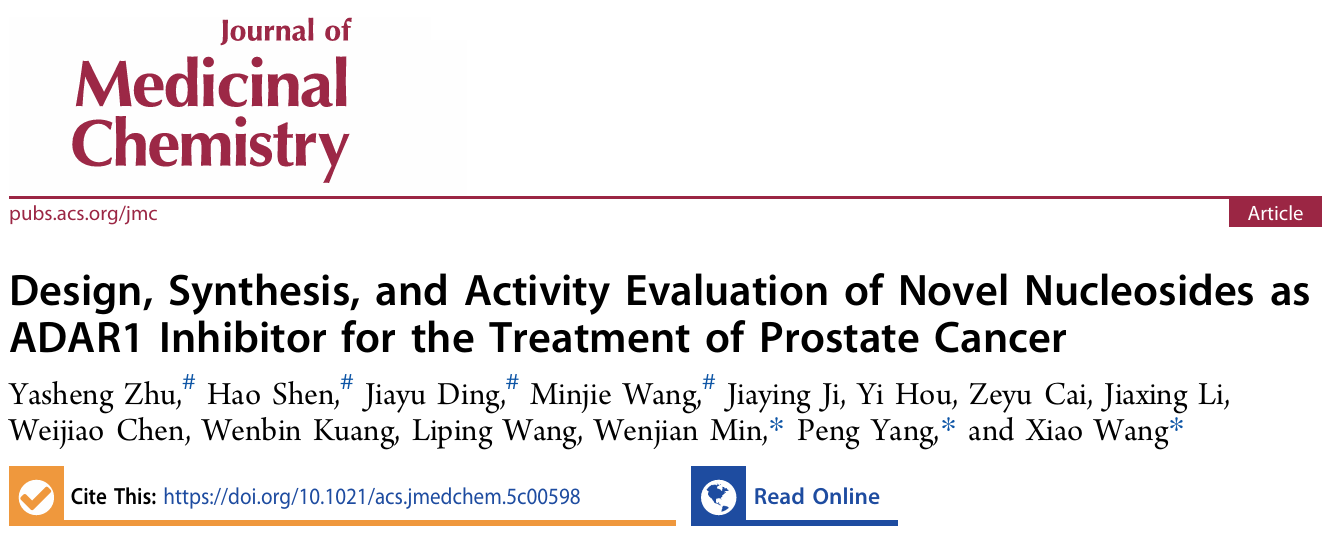
|
Title |
Design, Synthesis, and Activity Evaluation of Novel Nucleosides as ADAR1 Inhibitor for the Treatment of Prostate Cancer |
|
Journal Information |
J Med Chem. 2025 Jul 24;68(14):14495-14513. |
|
Cited products |
|
|
Catalog |
Product Name |
|
Recombinant Human ADARB1 Protein, N-His |
|
Based on the 2-chloroadenosine scaffold, this study designed and synthesized a series of novel nucleoside derivatives, systematically evaluating their anti-prostate cancer activity. Compound C12 demonstrated potent inhibitory effects against various prostate cancer cell lines (IC~50~ 0.72--1.79 μM). Mechanistic studies confirmed that C12 inhibits ADAR1-mediated RNA A-to-I editing through high-affinity binding to ADAR1 (Kd=140 nM), subsequently downregulating key genes like GLI1, inducing cell cycle arrest and apoptosis. Mouse xenograft models further showed that C12 safely and significantly inhibited tumor growth, suggesting its potential as an ADAR1 inhibitor for prostate cancer treatment.
The article cited AntibodySystem's Recombinant Human ADARB1 Protein, N-His (Cat. No. YHF70001) for Surface Plasmon Resonance (SPR) experiments. ADARB1 (ADAR2), ADAR1, and ADA proteins were immobilized on a CM5 chip to test the binding specificity of compound C12. Results showed C12 exhibited significant binding only to ADAR1 (Kd = 140 nM), with no apparent interaction with ADAR2 or ADA, confirming its selective targeting of ADAR1.
3
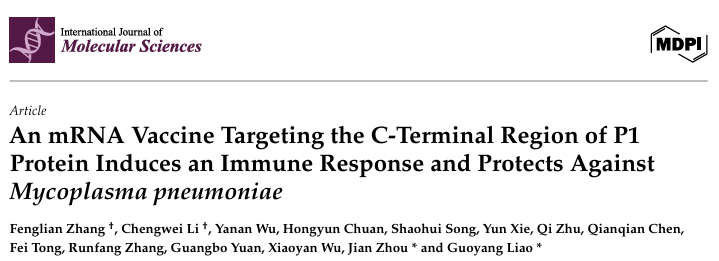
|
Title |
An mRNA Vaccine Targeting the C-Terminal Region of P1 Protein Induces an Immune Response and Protects Against Mycoplasma pneumoniae |
|
Journal Information |
Int J Mol Sci. 2025 Jul 7;26(13):6536. |
|
Cited products |
|
|
Catalog |
Product Name |
|
YXX09301 |
Recombinant Mycoplasma pneumoniae mgpA/Adhesin P1 Protein, N-His |
This study constructed and evaluated an mRNA vaccine, mRNA-SP+P1, targeting the C-terminal region (aa 1288--1518) of the P1 protein from Mycoplasma pneumoniae. Following three intramuscular immunizations, the vaccine induced high-titer P1-specific IgG and significant CD4+/CD8+ effector memory T cell responses in BALB/c mice. Immune sera significantly inhibited adhesion of the standard strain ATCC M129 to KMB17 cells and alleviated weight loss, temperature fluctuations, lung bacterial load, and pathological damage after challenge with ATCC M129 or the drug-resistant ST3 strain. Protection lasted up to 62 days post-booster. Transcriptome analysis further confirmed the vaccine activated immune-related pathways at the molecular level, suggesting its potential as a novel candidate vaccine against mycoplasma infection and resistant strain spread.
The article cited AntibodySystem's Recombinant Mycoplasma pneumoniae mgpA/Adhesin P1 Protein, N-His (Cat. No. YXX09301) for ELISA: Microplates were coated with 1 μg/mL of the protein to detect P1-specific IgG antibody levels in immunized mouse sera. Results showed antibody titers in the mRNA-SP+P1 group increased with each immunization, reaching 10⁶--10⁷ after three doses, significantly higher than the empty LNP control (p < 0.001). Therefore, this P1 protein served as a reliable coating antigen to verify the vaccine-induced humoral immune response.
4
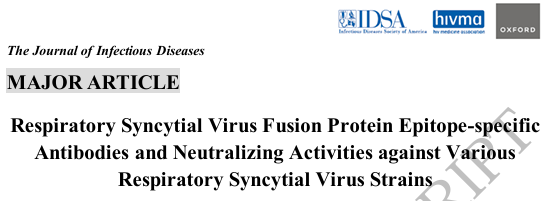
|
Title |
Respiratory Syncytial Virus Fusion Protein Epitope-specific Antibodies and Neutralizing Activities against Various Respiratory Syncytial Virus Strains |
|
Journal Information |
J Infect Dis. 2025 Jul 18:jiaf375. |
|
Cited products |
|
|
Catalog |
Product Name |
|
Anti-HRSV-A F/Fusion glycoprotein F0 Antibody (MPE8) |
|
|
Research Grade Suptavumab |
|
This study systematically assessed epitope-specific antibody (ESA) levels against five major neutralizing epitopes (II, III, IV, V, Ø) of the respiratory syncytial virus (RSV) F protein and their association with neutralizing activity (NA) against various clinical isolates in serum from 92 healthy Japanese adults. Results showed significant differences in ESA levels across epitopes, with sites IV and Ø having the lowest levels. ESA levels positively correlated with viral NA, but the strength of correlation varied depending on the viral subtype and the presence of resistance mutations, suggesting epitope selection for interventions needs to consider prevalent strain variations.
The article cited two AntibodySystem monoclonal antibodies: Anti-HRSV-A F/Fusion glycoprotein F0 Antibody (MPE8) (Cat. No. RVV02814) (targeting site III) and Research Grade Suptavumab (Cat. No. DVV02807) (targeting site V), for competitive ELISA to measure serum ESA concentrations against the corresponding sites. Experiments found site III ESA levels highly correlated with site II and IV ESA levels (r=0.84, 0.75), and site V ESA levels significantly correlated with NA against most RSV subtypes. This indicated that although site V and Ø antibodies were present at lower concentrations, their functional contribution was prominent, suggesting they should be key targets for vaccine and monoclonal antibody development.
5
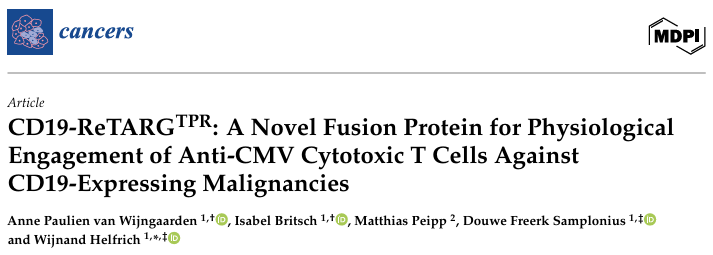
|
Title |
CD19-ReTARGTPR: A Novel Fusion Protein for Physiological Engagement of Anti-CMV Cytotoxic T Cells Against CD19-Expressing Malignancies |
|
Journal Information |
Cancers (Basel). 2025 Jul 10;17(14):2300. |
|
Cited products |
|
|
Catalog |
Product Name |
|
Research Grade Rituximab |
|
This study constructed a single-chain fusion protein named CD19-ReTARGTPR. It fuses the CMV pp65 antigenic peptide-TPR-HLA-B*07:02/β2m complex via a flexible linker to an anti-CD19 Fab fragment. This decorates CD19-expressing hematological malignancies with "pseudo-CMV antigens," enabling their recognition and killing by the patient's pre-existing anti-CMV CD8+ T cells. In vitro experiments showed this strategy efficiently killed multiple CD19+ cell lines and primary CLL cells, remaining effective against tumors with low CD19 expression. Induced cytokine levels (e.g., IFN-γ, IL-6) were only 1/100--1/400 of those seen with CAR-T or BiTE therapies, and effector T cell activation-induced cell death (AICD) was minimal. This suggests CD19-ReTARGTPR can maintain efficacy while significantly reducing cytokine release syndrome (CRS) and AICD risks, offering a more physiological and safer T cell redirection immunotherapy for CD19-positive malignancies.
The article cited AntibodySystem's recombinant monoclonal antibody Research Grade Rituximab (Cat. No. DHC90705) for comparative control experiments alongside blinatumomab and CD19-CAR-T cells. Rituximab and the other three agents were added to co-cultures of CD19+ tumor cells and effector cells. Tumor cell apoptosis rates were measured by Annexin-V/PI flow cytometry at 24h, and cytokine levels (IFN-γ, TNF-α, IL-6, etc.) in culture supernatants were measured by ELISA and a 42-plex array. Results showed rituximab itself lacked direct cytotoxicity. In contrast, CD19-ReTARGTPR achieved killing efficiency comparable to CAR-T/BiTE (despite rituximab's inactivity) but induced significantly lower cytokine storm (100--400-fold reduction). Therefore, CD19-ReTARGTPR enables highly effective, low-toxicity killing even when rituximab is ineffective, outperforming traditional anti-CD19 therapies.
6

|
Title |
Pralatrexate effectively inhibits the replication of monkeypox virus in vitro and in vivo |
|
Journal Information |
Antiviral Res. 2025 Sep:241:106232. |
|
Cited products |
|
|
Catalog |
Product Name |
|
Mouse Anti-Monkeypox virus/MPXV E8L Antibody (SAA0285) |
|
|
Anti-Monkeypox virus/MPXV F3L Polyclonal Antibody |
|
This study systematically evaluated the anti-monkeypox virus (MPXV) activity of the approved anti-cancer drug pralatrexate (PDX). In vitro, PDX potently inhibited MPXV replication at very low concentrations (IC~50~ ≈7--8 nM), with a selectivity index >1200. In vivo, using a Spanish dormouse model, daily intraperitoneal administration of 1.5 mg/kg PDX significantly reduced viral loads in multiple organs, alleviated pathological damage, and reversed weight loss. Mechanistic studies revealed PDX primarily blocks viral entry and early replication stages, not its classic antifolate pathway. The study concludes PDX is a safe, effective, and potentially superior alternative to the current drug tecovirimat for MPXV treatment.
This study systematically evaluated the anti-monkeypox virus (MPXV) activity of the approved anti-cancer drug pralatrexate (PDX). In vitro, PDX potently inhibited MPXV replication at very low concentrations (IC~50~ ≈7--8 nM), with a selectivity index >1200. In vivo, using a Spanish dormouse model, daily intraperitoneal administration of 1.5 mg/kg PDX significantly reduced viral loads in multiple organs, alleviated pathological damage, and reversed weight loss. Mechanistic studies revealed PDX primarily blocks viral entry and early replication stages, not its classic antifolate pathway. The study concludes PDX is a safe, effective, and potentially superior alternative to the current drug tecovirimat for MPXV treatment.
7

|
Title |
Concept of natural genome reconstruction. Part 3. Analysis of changes in the amount of telomeric DNA in colony cells as a new amplified feature that arose during the processing of hematopoietic bone marrow stem cells |
|
Journal Information |
Vavilovskii Zhurnal Genet Selektsii. 2025 Jul;29(4):479-495. |
|
Cited products |
|
|
Catalog |
Product Name |
|
Anti-TERT Antibody (R2T86) |
|
Using mouse, rat, and human bone marrow hematopoietic stem/progenitor cell models, this study explored the impact of an induced "recombination context" by exogenous double-stranded DNA fragments (hDNAgr) or recombinant human angiogenin on telomeric DNA content. Through quantitative dot blot, pulsed-field gel electrophoresis, real-time PCR, and Western blot, it was found that hDNAgr significantly increased telomeric DNA (up to 2.5-fold) via an "alternative lengthening of telomeres (ALT)" pathway or direct integration of exogenous telomeric sequences into host telomeres, independent of telomerase. Angiogenin, however, elongated telomeres by activating endogenous telomerase (TERT) expression. The study established a new technical principle for the amplification and fixation of exogenous genetic information in hematopoietic stem cells, providing a theoretical basis for gene therapy and stem cell engineering.
The article cited AntibodySystem's Anti-TERT Antibody (R2T86) (Cat. No. RHA28703) for Western blot detection to validate changes in telomerase protein expression. Results showed specific TERT bands (~35 kDa and ~63 kDa) appeared in the angiogenin or combination treatment groups after 8--32 hours, while the hDNAgr alone group showed no detectable TERT protein. This result aligned with the upregulation of TERT mRNA observed by real-time PCR in the angiogenin group, confirming that angiogenin increases telomeric DNA content by activating endogenous telomerase activity, whereas hDNAgr achieves telomere lengthening via a telomerase-independent pathway.
